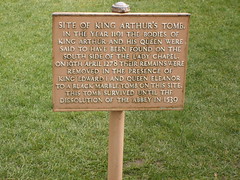King Arthur
Commemorated on 1 plaque
Site of King Arthur's Tomb. In the year 1191 the bodies of King Arthur and his Queen were said to have been found on the south side of the lady chapel. On the 19th April 1278 their remains were removed in the presence of King Edward I and Queen Eleanor to a black marble tomb on this site. This tomb survived until the dissolution of the abbey in 1539
Glastonbury Abbey, Glastonbury, United Kingdom where they was found (1190-1277)


